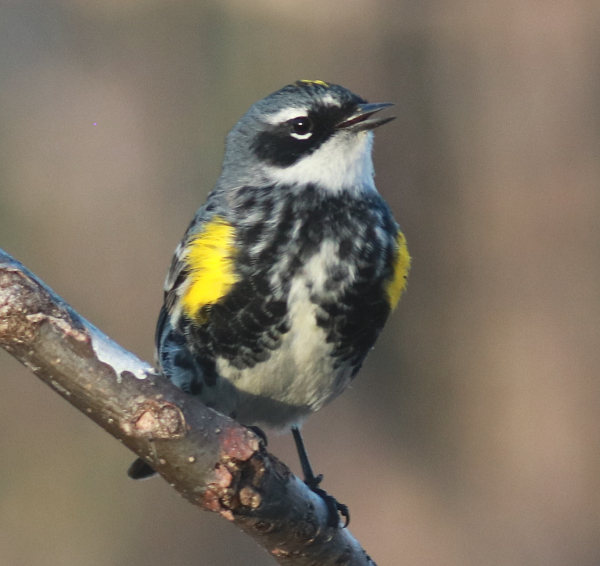
Can you identify this Yellow-rumped Warbler by its song? (photo by Paul Konrad)

Don Kroodsma with bird song recording equipment in a South Carolina marsh (photo by Janet Grenzke).
|
This time of year the air is vibrant with a mix of bird songs from before sunrise to after sunset. How are you at birding by ear? Learning to recognize and identify birds by ear takes time, experience, and a little help from a friend – or from Don Kroodsma, a noted bird song expert who has been studying bird songs a half-century. The noted author recently explained how a birder can get started or improve their skills at birding by ear. Kroodsma suggested to start by slowing down and taking the time to listen to birds as individuals.
Don Kroodsma is Professor Emeritus at the University of Massachusetts and a distinguished author who has written a number of books about bird songs, including The Singing Life of Birds, the Art and Science of Listening to Birds, and Birdsong by the Seasons; plus the unique and popular Backyard Birdsong Guides. A recent interview with Dr. Kroodsma follows:
How Do We Begin To Get Familiar With Bird Songs? Don Kroodsma: The same way we get to know people, I suggest. Imagine that you move to a new town and want to figure out who’s who. You get to know one person at a time, starting with a neighbor perhaps, getting to know that person well enough so you’d rarely, if ever, mistake them for another person. Then you get to know the next person. You wouldn’t start with 100 people gathered in an auditorium and race from one person to the next. I advocate “identifying with” birds instead of just “identifying” birds.
Can You Explain What You Mean By “Identifying With” Birds? Don: For me, I listen to every individual bird because every bird is different; each individual is saying something different and it is enjoyable to listen to it with that kind of detail. I would suggest picking any species that you already know. To listen to a Red-winged Blackbird, you could visit a marsh and watch and listen to individual birds. In my Backyard Birdsong guides I provide lessons about how to listen to individuals of many species.
What Would Be An Example Of Listening To Individuals? Don: A Song Sparrow has about 8 different songs. Instead of developing some superficial tricks to identify a Song Sparrow, sit and listen to an individual and hear it sing one particular song over and over. Eventually, after perhaps 10 to 20 repetitions, it will switch to another song. That way, you learn about how an individual bird expresses itself. When you do that with a couple of Song Sparrows, you will know Song Sparrows well enough that you will never confuse them with another species. As you listen to birds with that kind of detail – what I call “deep listening” – one by one you come to know that species and the variations among individuals within a species. You begin to listen at a different level, one bird at a time; then identifying the “species” comes easily.
Are People Who Have Some Musical Training Or Ability Better At Detailed Listening? Don Kroodsma: Possibly, but I more or less flunked piano lessons as a child. I think it’s more important to just have “auditory memory,” an ability to hear a sound and recognize it again, or know that it is different from other songs or sounds.
How Can Someone Improve Their Auditory Memory? Don: Recording sounds is one way. I enjoy recording birds because it’s as if the bird is singing into your ear. After recording I enjoy looking at those same songs in spectrograms because I think it’s fairly accurate to say that I hear with my eyes, which are so much better trained than my ears. When I see the song and hear the song simultaneously, the eyes teach the ears how to listen, and vice versa. You can also just use a pen and paper to sketch out what a bird is doing in song – perhaps using a long straight line for a whistle, or short jagged lines for rattles, and so forth. I think we already do this mentally as we are finding the patterns in a song. Sketching the pattern visually reinforces what our ears hear.
You’ve Been Studying Bird Sounds for 50 Years; How Did You Get Started? Don Kroodsma: During the summer of 1968, former Cornell Lab Director Sewell Pettingill taught ornithology at the University of Michigan field station, and he asked me to record some bird songs for the Lab’s Library of Natural Sounds (now the Macaulay Library). The rest, as they say, is history! Even after all this time I realize that the more we learn the less we know about bird songs. But in the end, I find it immensely satisfying to stand or sit in one place, perhaps with my eyes closed, and hear all that is going on around me; and to not only know ‘who is who,’ but also a bit of what they’re expressing in their songs.
We hope the above information is helpful as the spring season brings “new” bird songs into our lives. You will appreciate how satisfying it is to be able to identify birds by their songs and calls, and how you will build your own mental library of bird songs as each spring progresses. The above interview with bird song expert Don Kroodsma was conducted by Pat Leonard and originally published in Living Bird magazine. To refer to the original interview, see https://www.allaboutbirds.org/news/learn-bird-songs-by-listening-deeply-qa-with-don-kroodsma/
Share your birding experiences and photos at editorstbw2@gmail.com